Programme
28 mars 2022
ECAL/Ecole cantonale d'art de Lausanne
Avec :
Ludivine Bantigny
Persis Bekkering
Agnès Gayraud
Caroline Poggi
Jonathan Vinel
Philippe Azoury, Stéphanie Moisdon & Vincent Normand
Introduction
Philippe Azoury, Stéphanie Moisdon & Vincent Normand
Introduction
Ludivine Bantigny
Representing Youth / Experiencing It. A Historical Perspective.
The representations, discourses and other obsessions about "youth" often say less about young people than about the authorities that forge them: politicians, institutions, media, artists... In themselves, these representations are interesting: they express anxieties, doubts and hopes, but also strong opinions, sometimes peremptory visions that often translate fantasies. In such a landscape, cinema in particular is an excellent medium when it projects its lights and cameras on youth. It is these ways of telling the story of youth that this presentation addresses. But it does not stop there. For beyond the representations, what remains the most fascinating are the modalities of socialization that young people know and come across, in all their diversity. In this sense, this presentation will also question the relationship to time, historicity as an awareness of taking part in history and situating oneself in it, age identities, and generational belonging.
Ludivine Bantigny
Representing Youth / Experiencing It. A Historical Perspective.
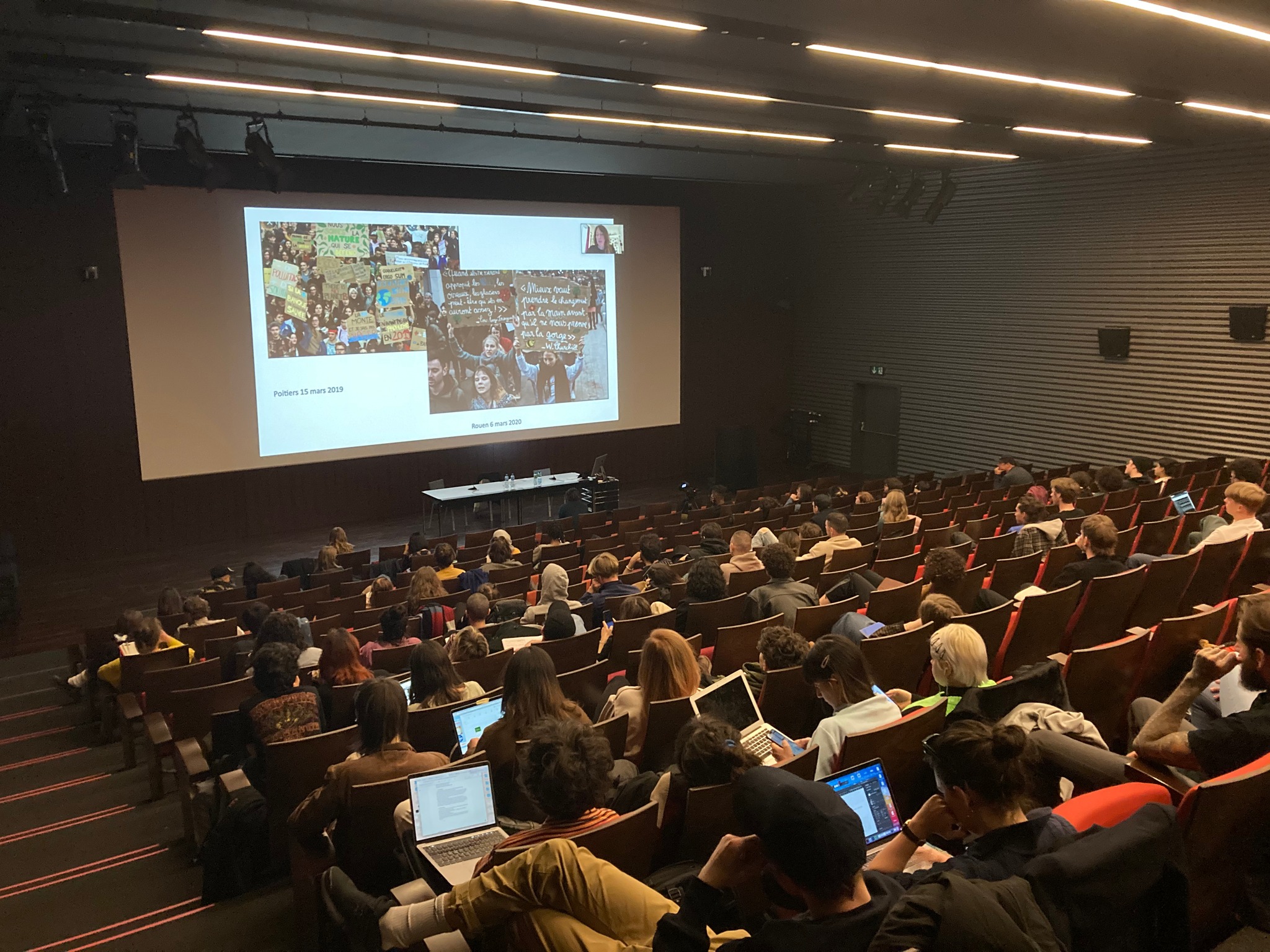
Ludivine Bantigny
Representing Youth / Experiencing It. A Historical Perspective.
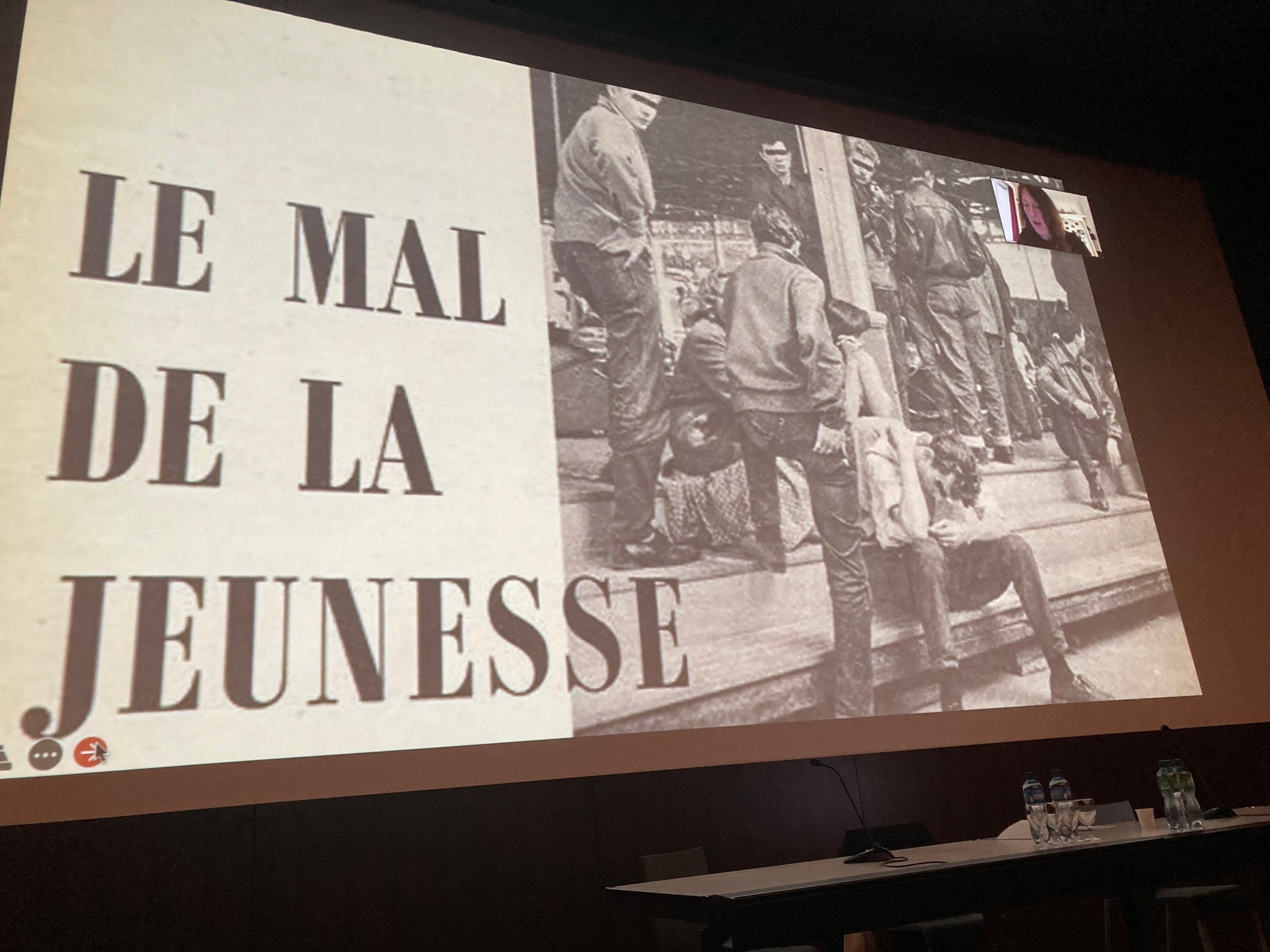
Ludivine Bantigny
Representing Youth / Experiencing It. A Historical Perspective.
Agnès Gayraud
"Will You Love Me When I'm Sixty Four?" Pop Music as an Art of Ages
Folklore has long been interpreted as the "childhood of art", a form of expression invented by popular classes and considered as the living vestige of humanity’s childhood. From its outset, recorded folk music has been appreciated as a form of "primaverism", the conviction that things in their prime are the most valuable, that authenticity stems not only from the origin but from the beginning.
A recording fixes individual voices and their organic idiosyncrasies at the moment of their expression, and in so doing, it captures the aura of a primitive past. The fixed expressivity of recorded voices represents countless individual incarnations, and this has made pop music the most powerful musical art form to bear witness to all ages of life, not just childhood or youth. Rather than associating pop music with a particular stage of life, with a phase of inexperience (innocence, naivety, regression or youth), it is tempting to question its rooting in the expression of ages in general.
Contemporary musicians such as Angèle, Oklou, and Arca accurately represent post-adolescence, sexual maturity, and the pleasure of finally flirting with the pornographic category of "adult" content, all while reflecting on youthism, contemporary ageism, and sexist domination. Here, individual embodiment takes as its theme its own situated expression. In contrast to these younger artists, Bob Dylan sang later in his life,"It's not dark yet but it's getting there". This priority given to the expression of individuality at various ages (one’s body, one’s sexuality, one’s race, which make sense only by situating a generation in terms of someone's legal and physiological age), is what binds deeply popular recorded music to what the history of western musical art has at some point thought to have overcome during the 20th century: the romantic confidence in situated individualities, in particular incarnations, in singularities. In the contemporary artistic field, reflexive forms of art only recognize their historical age. Individual age is not a key to understanding the content of their gesture, one deciphers it rather in light of their epoch. Popular music, to the contrary, presents itself as a musical art powerfully carried by the expressiveness of the ages, even if it means sometimes to render eternal a youth whose legal status as such proceeds from the whole liberal system.
Agnès Gayraud
"Will You Love Me When I'm Sixty Four?" Pop Music as an Art of Ages
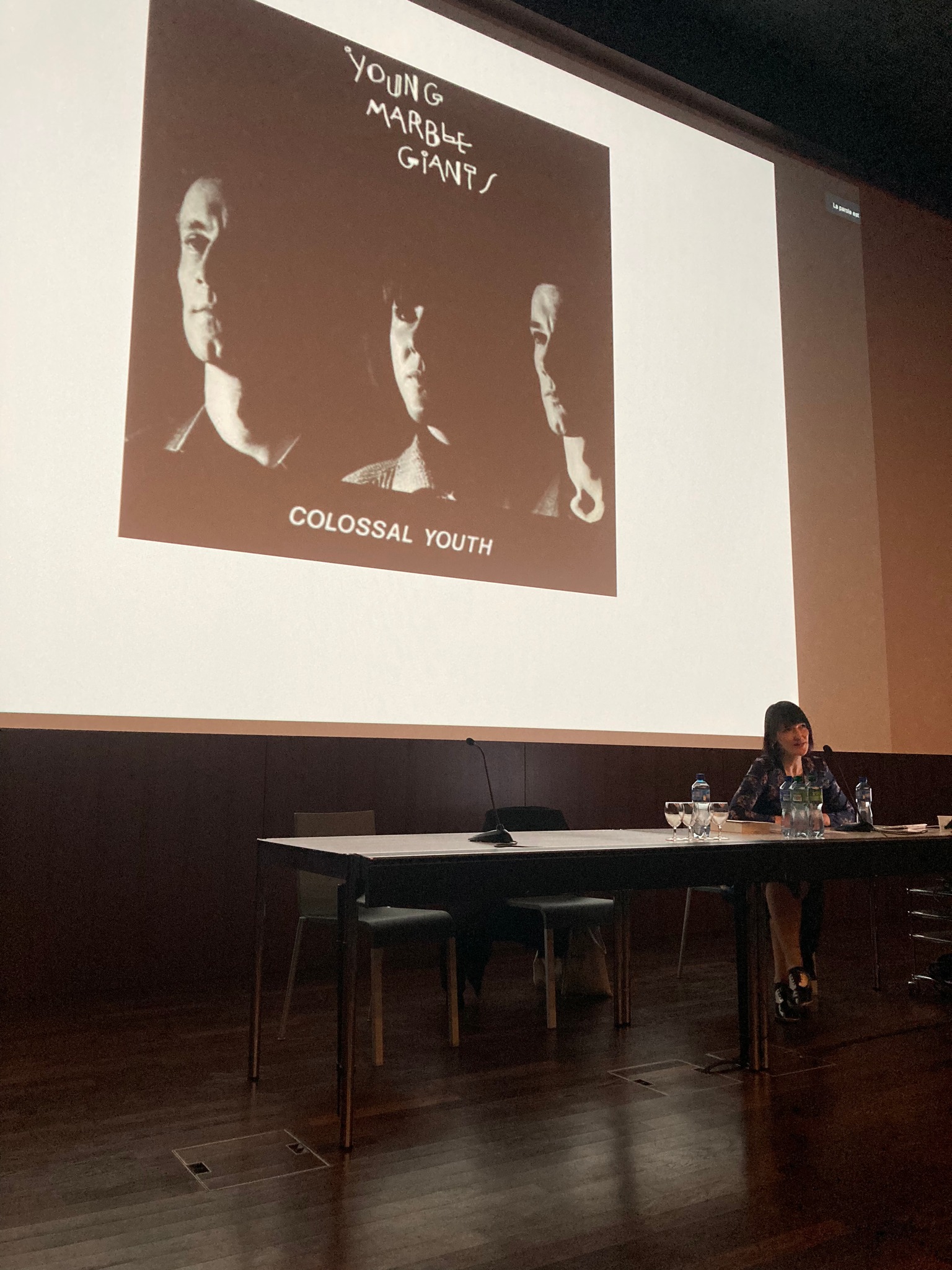
Agnès Gayraud
"Will You Love Me When I'm Sixty Four?" Pop Music as an Art of Ages
Persis Bekkering
The Rave Continuum. Researching Plot and Politics of "Europe's Last Youth Culture"
As much as any experience fails to be adequately grasped by language, the experience of the rave presents the storyteller with a specific, intriguing challenge. As the narrator in Rainald Goetz' experimental novel Rave (1998) remembers: "It was the wordless time, when we were always looking around with our big eyes so strangely in every possible situation, shaking our heads, and could almost never say anything but: speechless – pf –"
The rave, at its best, is a wordless suspension of time; a limit experience; an event blurring linear understandings of time and space, proposing its own logic. As music theorist Simon Reynolds once quoted the (unbelievably perfect) shouts of an MC at a hardcore party: 'We've lost the plot'. What does this mean if one tries to translate the rave into narrative? How to grasp its thwarted, warped, halted temporality?
For her last novel Exces, part of which is published in English as the novella Last Utopia, writer Persis Bekkering has attempted to find an answer to these problems. The questions of narrative structure and temporality of the rave may look like purely formal ones, but they are closely tied to bigger, historical or even philosophical questions: how to understand the rave and the emergence of rave culture, at the end of the 1980s, in its time? Why did it emerge at that peculiar historical moment, when the end of history and telos of progress was famously declared, utopian ideologies lost their claim, and capitalism entered a new phase? And what did the rave propose to it: resistance or acceleration? Maybe both?
In her presentation, Bekkering takes us through a meandering journey along her ongoing artistic and literary research, sharing images, texts, fragments and shouts in the dark, from her archive. Throughout the various parts and fragments, one can hear the constant drone of the search for the aesthetic expression of the permanent presence of crisis in our time.
Persis Bekkering
The Rave Continuum. Researching Plot and Politics of "Europe's Last Youth Culture"
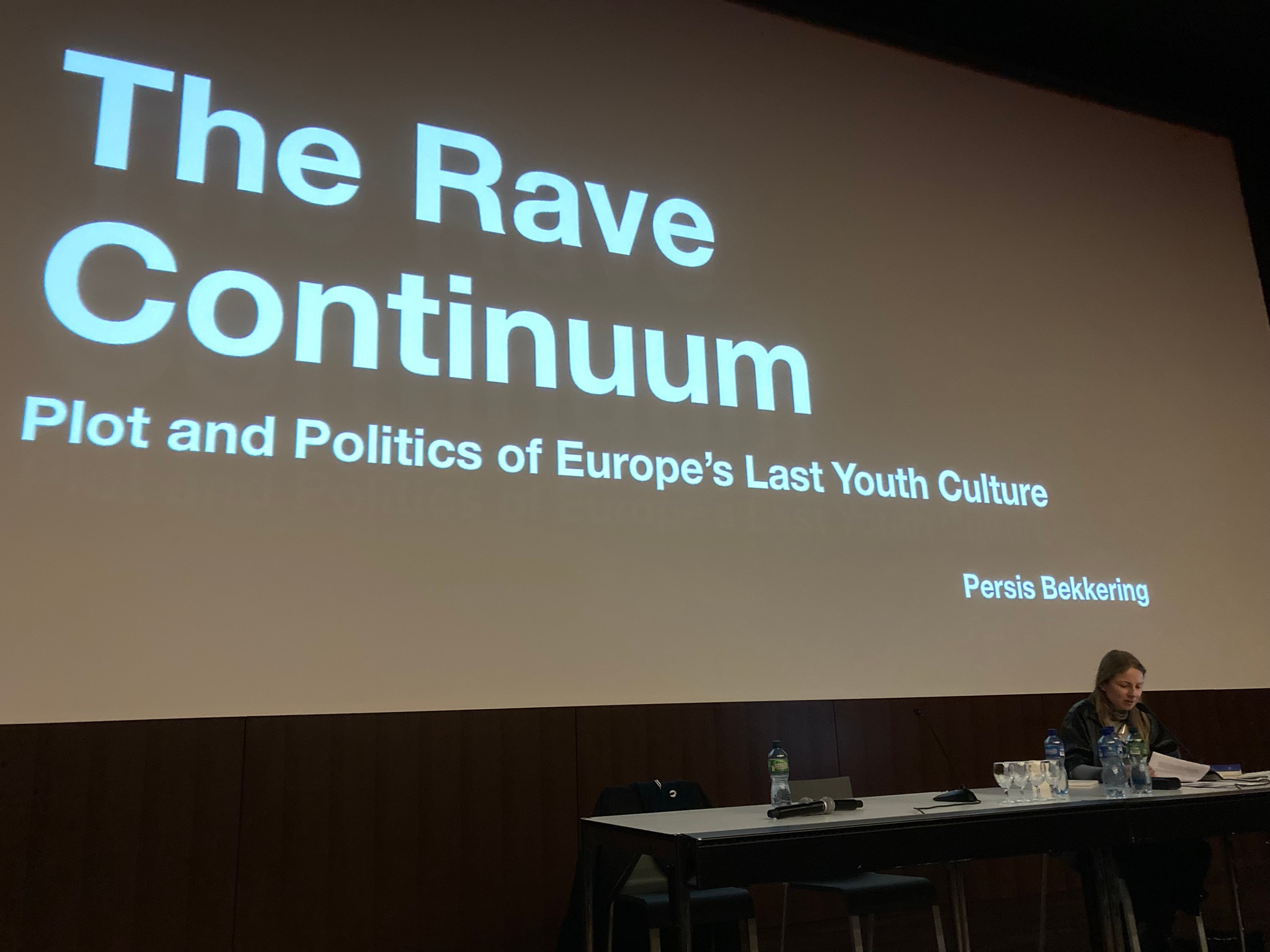
Persis Bekkering
The Rave Continuum. Researching Plot and Politics of "Europe's Last Youth Culture"
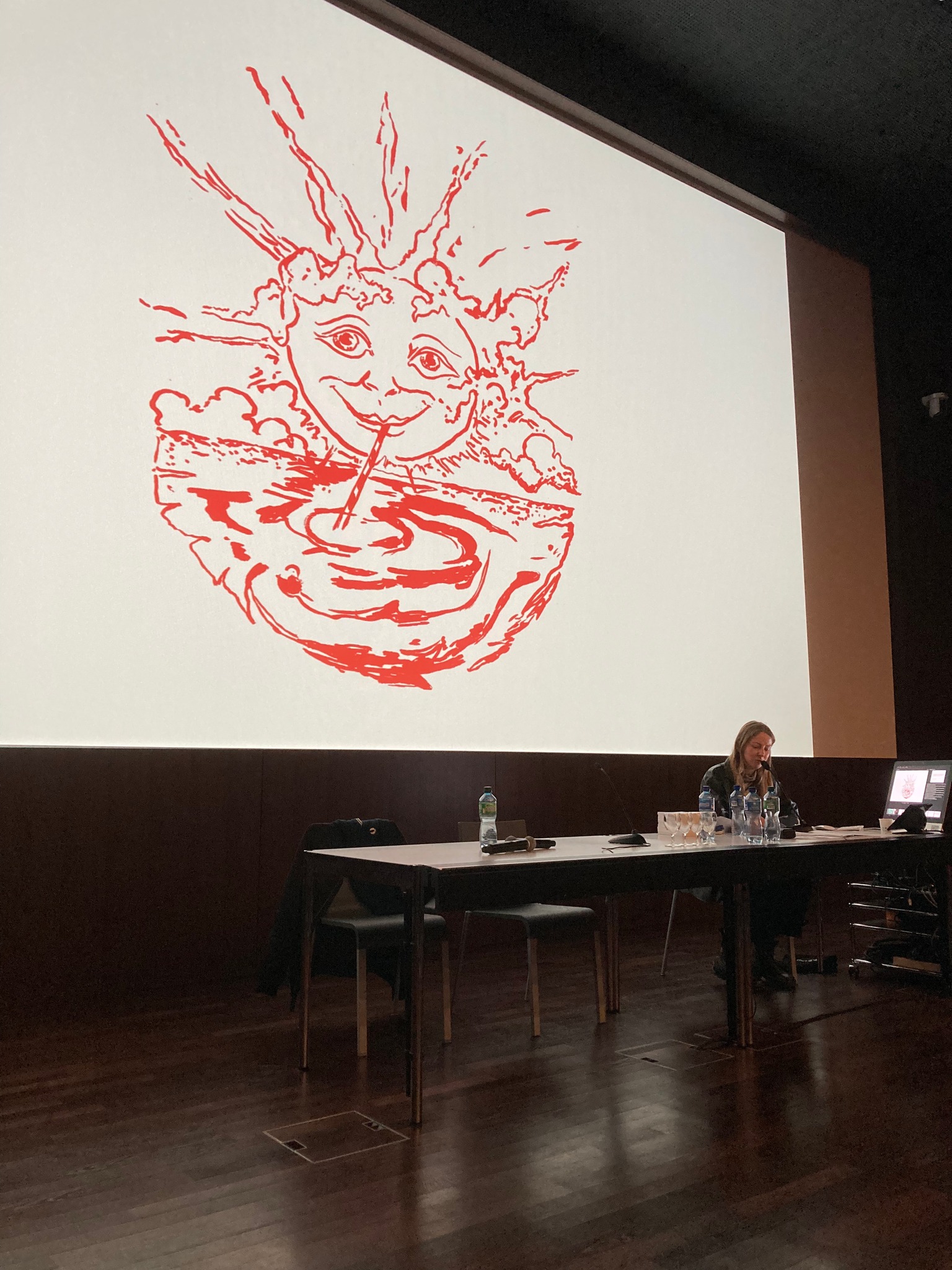
Persis Bekkering
The Rave Continuum. Researching Plot and Politics of "Europe's Last Youth Culture"
Caroline Poggi & Jonathan Vinel
About Bébé Colère
For more than ten years now, Caroline Poggi and Jonathan Vinel have been weaving together a body of work that has no equivalent within French cinema. Whether through their first feature film Jessica forever (2018), or through their numerous short and medium-length films, (Martin pleure, 2017; Notre héritage, 2015; or Tant qu'il nous restera des fusils à pompe, 2014, which won the Golden Bear at the 2014 Berlin International Film Festival), they follow the destiny of their own generation (they are both less than 35 years old). This is a generation which feeds on heroism through the virtual, a generation that met porn before love and online violence before friendship, a generation for which the video game is its lost paradise.
Yet they draw from it, and this is their strength, a form of romanticism, which never wants to believe in the end of emotions. Their lyricism is unprecedented because it comes after: after the images, after the clichés, after the disillusionment, after they have been told that “no, really, sorry, there is nothing left to expect from anything, everything has been played out”.
In the spring of 2020, when the earth had just come to a halt due to the Covid pandemic, Jonathan and Caroline retreated to Corsica where they dreamed of an unseen body that escaped from a video game: Bébé Colère [Baby Anger]. Bébé Colère denies his parents, Bébé Colère has no friends, Bébé Colère vomits the world and feeds on emptiness.
In 13 minutes, Bébé Colère is an irreducible work that paints a portrait of a 2.0 youth caught in disarray. A post-human body, which has denied its origins and only sees the future through the features of an avatar.
Caroline Poggi and Jonathan Vinel will discuss the possibility of romanticism today, and the conditions that allow them to invent new characters, generating their own disordered chronology. They will also talk about their aesthetic relationship with video games: the baby in Bébé Colère is a pre-programmed asset purchased online to be animated and then integrated into the film. In close collaboration with Lucien Krampf, they are also currently developing a project conceived inside a game engine. In their work, they consider the game as a new narrative track while also using pre-existing elements.
Caroline Poggi & Jonathan Vinel
About Bébé Colère
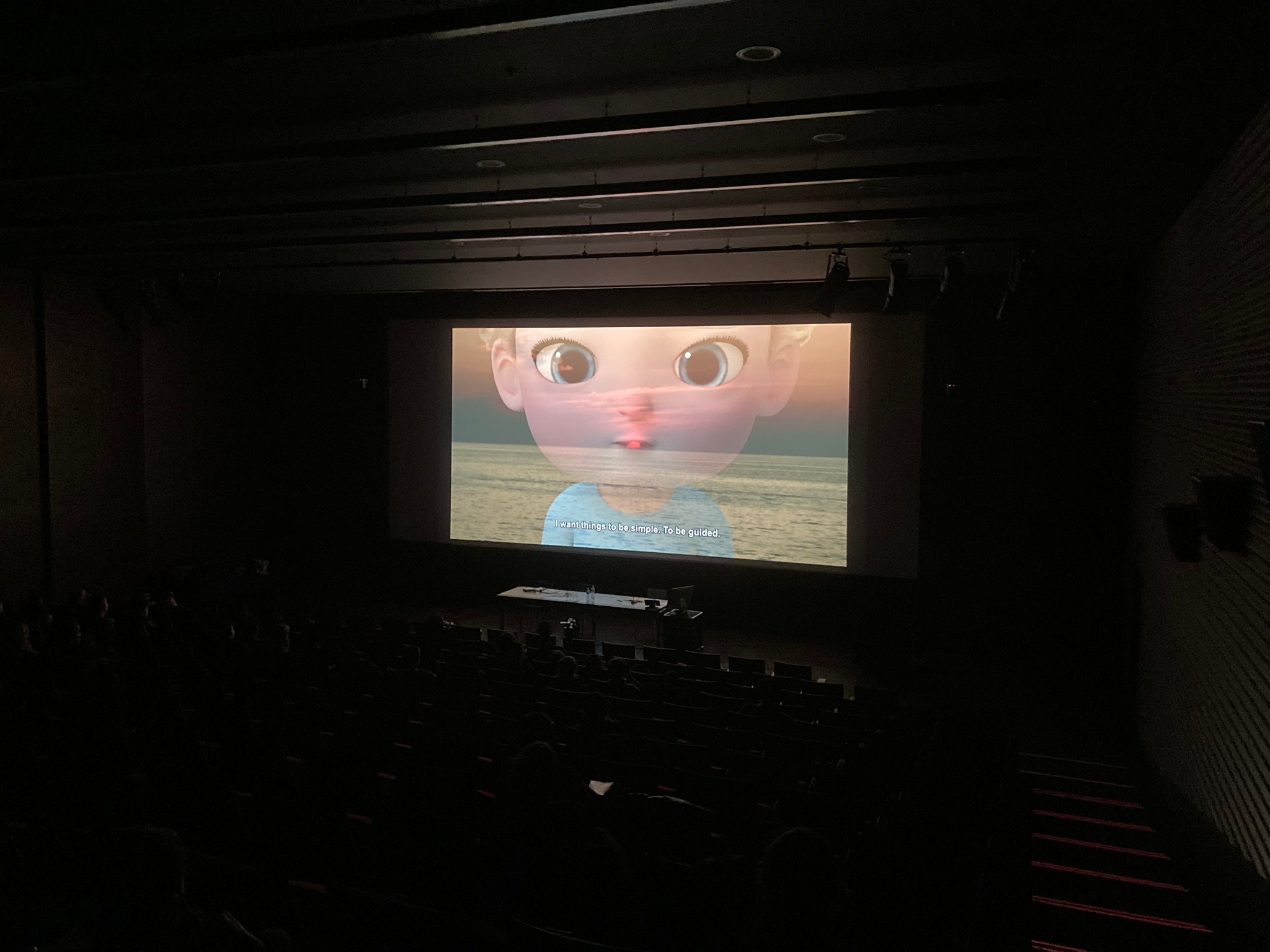
Caroline Poggi & Jonathan Vinel
About Bébé Colère
23 - 24 novembre 2022
ECAL/Ecole cantonale d'art de Lausanne
Avec :
Persis Bekkering
Florian Gaité
Ingrid Luquet-Gad
Julia Marchand
Persis Bekkering
Writing the Rave
This workshop aims to deepen and expand the material writer Persis Bekkering gathered in her presentation “The Rave Continuum”, delivered during the Master Symposium “How Soon Is Now” at ÉCAL, March 2022. Researching the emergence of rave culture in the 1980s and 1990s and its continuation in the unevenly ravaged nightlife scenes of today, Persis asked, what is the narrative structure of the rave? And once we’re able to read it as text, does it propose us an (alternative) epistemology?
The leading question in this workshop is therefore simple: how to write the rave? How to translate the wordless experience of the party, where in its best moments time comes to a halt, into language and story?
Bekkering will take the participants through a selection of essential texts, both fiction and theory, to collectively read and study the phenomenon of rave as a mode of expression. In the second part of the day, the participants are invited to write the rave themselves, understanding rave as narrative device, guided by Bekkering’s own findings as a novelist.
One of the aims of such an endeavour is finding ways of infusing language with the exhilarating physicality of the dance floor. In a more abstract sense, the workshop could function as heuristic training for translating discourse into artistic concepts and forms.
Writing experience is not required. Any language works. Bring your own preferred writing devices.
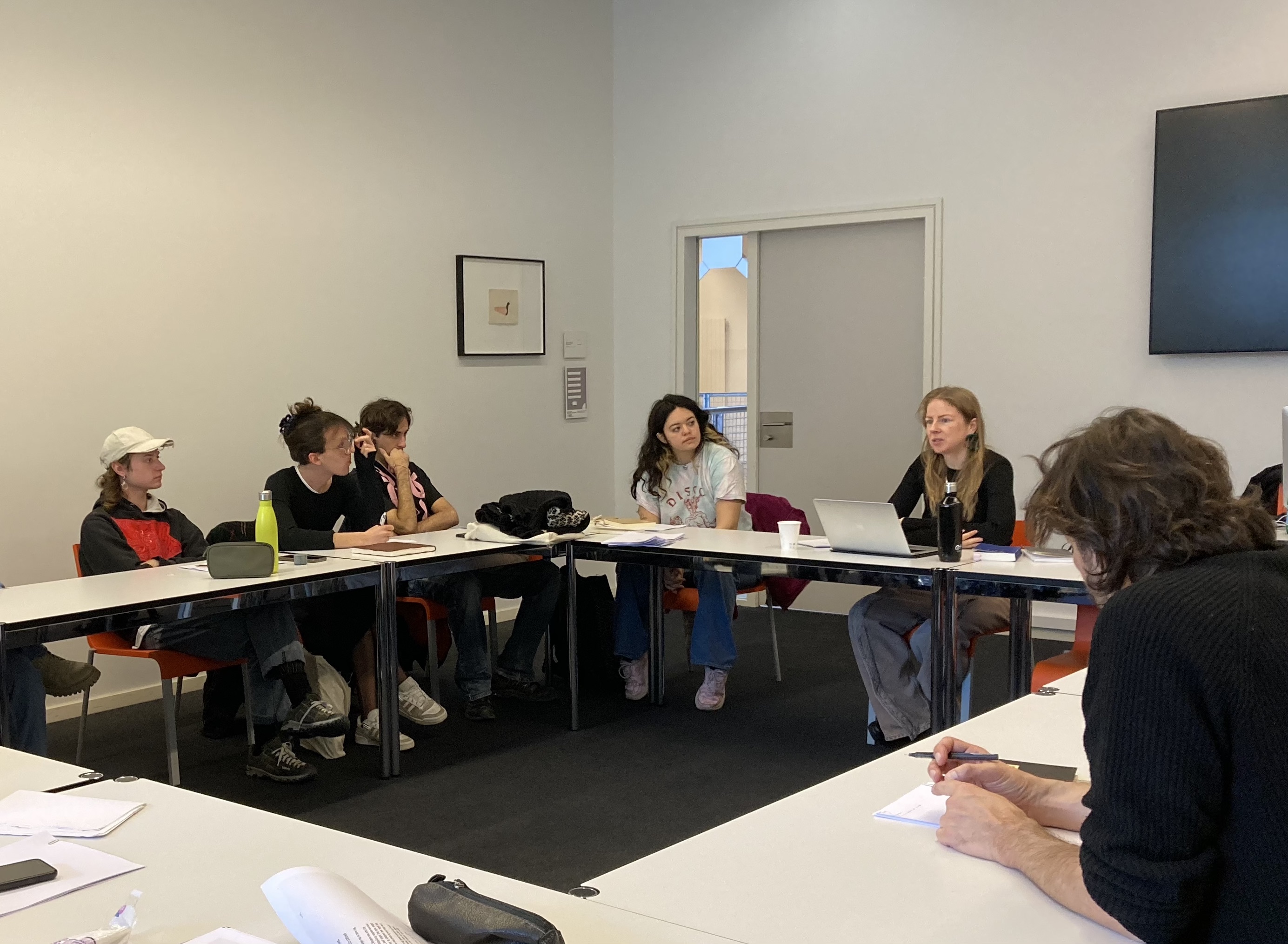
Persis Bekkering
Writing the Rave
Florian Gaité
Danser à mort. Du contrôle des corps à leur épuisement souverain dans les clubs techno.
Des corps exténués dans un club techno, on retient généralement l’image d’un lâcher-prise inconséquent, sans signification politique. Mais cette fatigue n’est-elle pas aussi une manière de résister aux injonctions néolibérales à la performance ? En portant notre attention sur leur indiscipline et leur incapacité à servir des intérêts productivistes, nous travaillons l’hypothèse selon laquelle cet épuisement oppose la « souveraineté » des dépenses vitales (Bataille) à la « maîtrise » des forces de production (Hegel). Ressaisi par ce biais, le club apparaît comme un lieu ambigu où s’affrontent deux logiques opposées de contrôle des corps : d’un côté leur exploitation marchande dans l’industrie du divertissement, de l’autre leur réappropriation critique dans une pratique de soi gratuite. Il s’agit donc de voir dans les corps affaiblis de ces danseur·se·s ravagé·e·s la marque d’une indocilité résistante par laquelle des sujets irrécupérables, c’est-à-dire ingouvernables, performent une autre façon de se tenir face à la mort, et échappent ainsi à l’industrialisation de la vie.
Florian Gaité
Danser à mort. Du contrôle des corps à leur épuisement souverain dans les clubs techno.
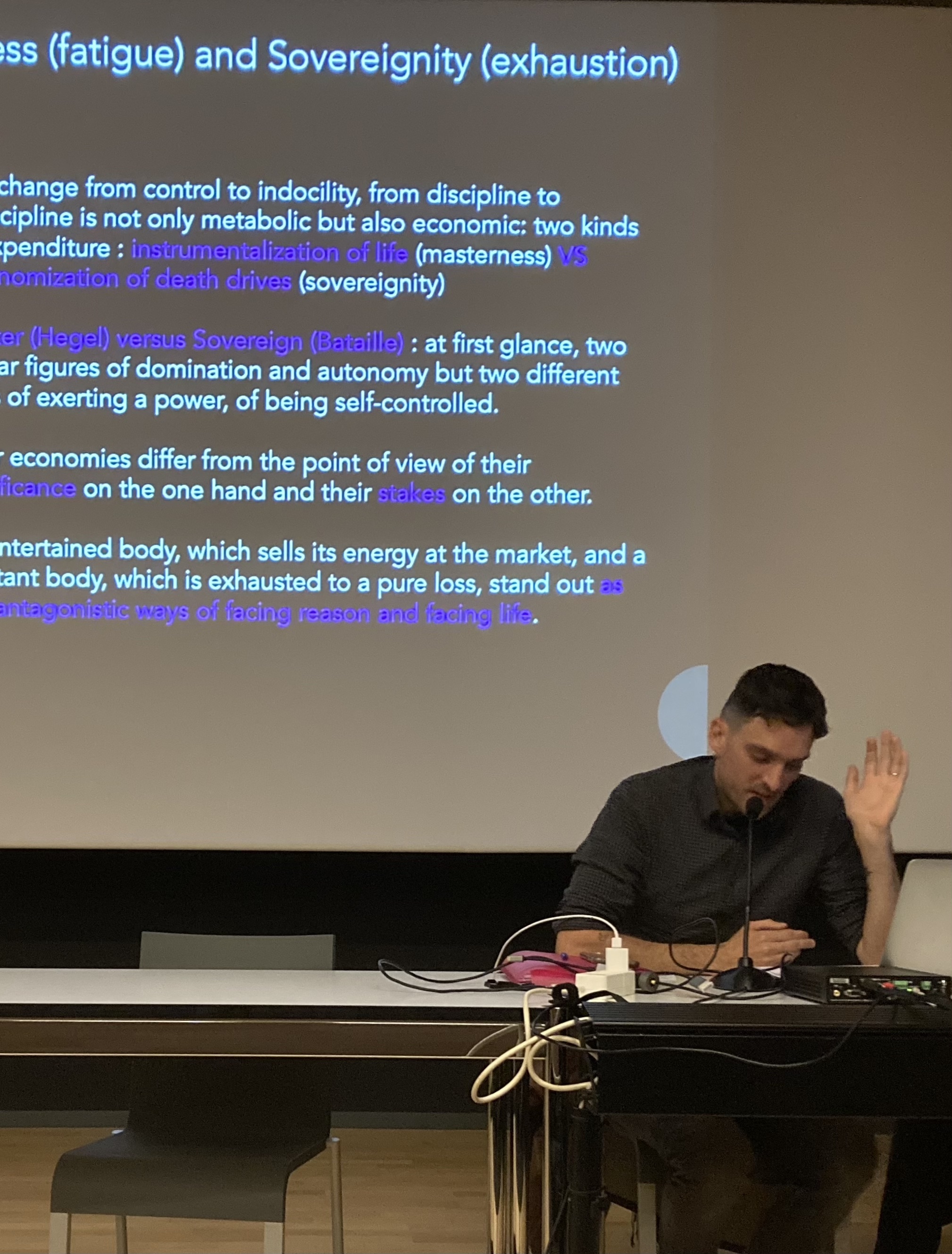
Florian Gaité
Danser à mort. Du contrôle des corps à leur épuisement souverain dans les clubs techno.
Julia Marchand
Red without color
In Diego Marcon’s recent film, The Parents’ Room (2021), a family member, the father, sings the murder of his own wife and two children as well as his own death. The pervading mourning of this film conveys a sense of melancholy which is attuned with a feeling of quietness. There is no trace of blood, neither of motivation or tangible objects that could have led to this monstrous act. In Jessica Forever (2018) by Caroline Poggi and Jonathan Vinel a group of young boys are being led by Jessica who take them on a journey where guns seem to have no real consequence and exist within a world of harmony. Drawing from early conversations with artist Kim Seob Boninsegni, which laid the foundation for the creation of the curatorial platform Extramentale, Red without color will explore the impending violence and pervasive melancholy which are at the core of specific artistic productions.
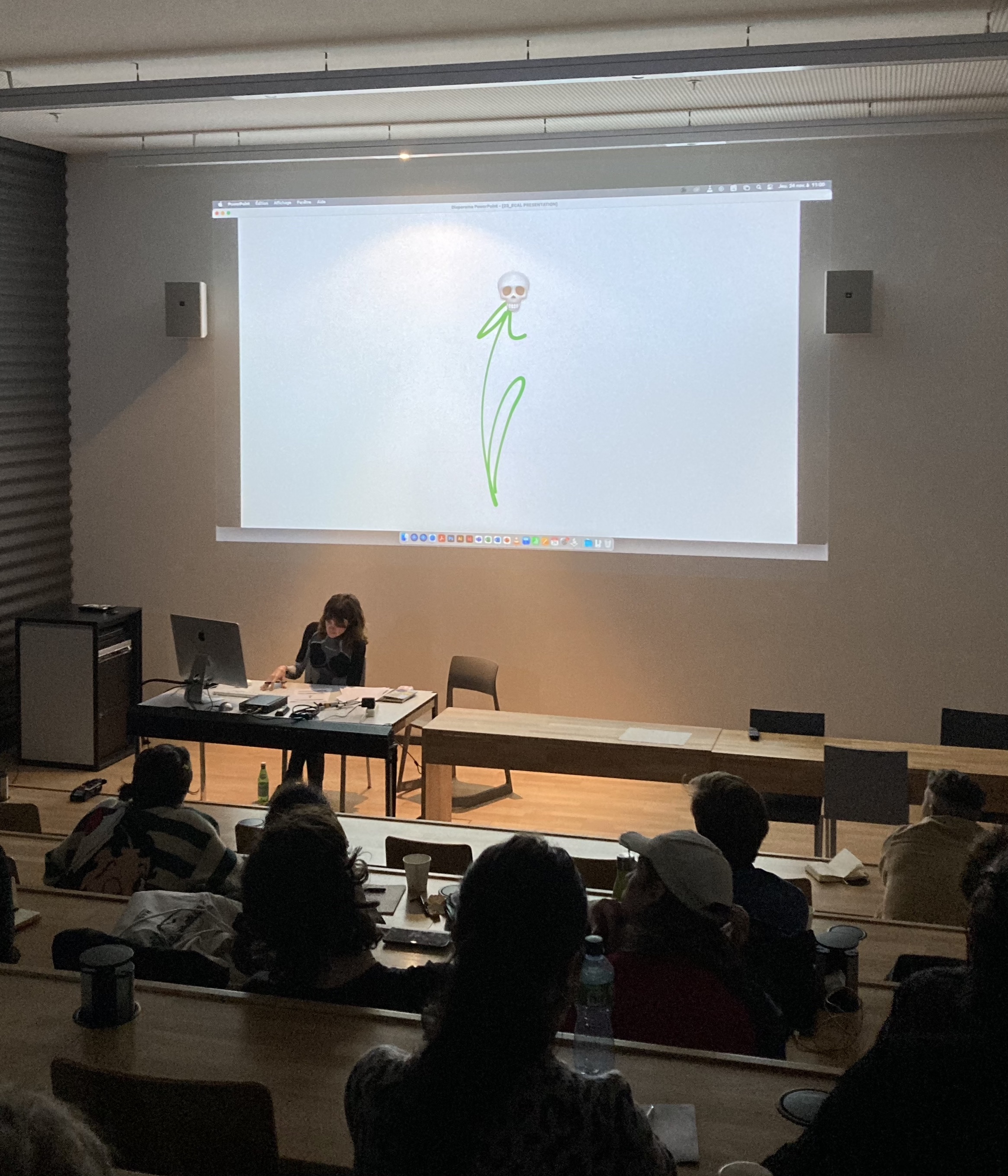
Julia Marchand
Red Without Color
Ingrid Luquet-Gad
Raised On The Internet: Now What?
The generation coming to age in the 2010 decade was marked by a double temporal movement. On the one hand, the cyber-utopias of the 1990s were taking speed: detached from the hardware, they had never been so close to be implemented in real life. On the other, this also meant the discovery of a newfound porousness, both a blessing and a curse, as any structure was now felt to have been integrally infiltrated by an all-encompassing planetary capitalism to which there was no outside.
For a loose group of art school dropouts assembled around the platform DIS Magazine, active from 2010 to 2016, this meant enacting a radical breach: away from the art-academia complex and from inherited institutional structures. If several articles were quick to identify a “Generation DIS”, here was a generation not only rebelling against, but ignoring, its forebears; one opting, instead of the well-trodden path of “no future”, for that of “no past”. More productively this time, what was at play was also how to imagine oneself anew, and radically so -- without models nor anti-models.
Ingrid Luquet-Gad
Raised On The Internet: Now What?
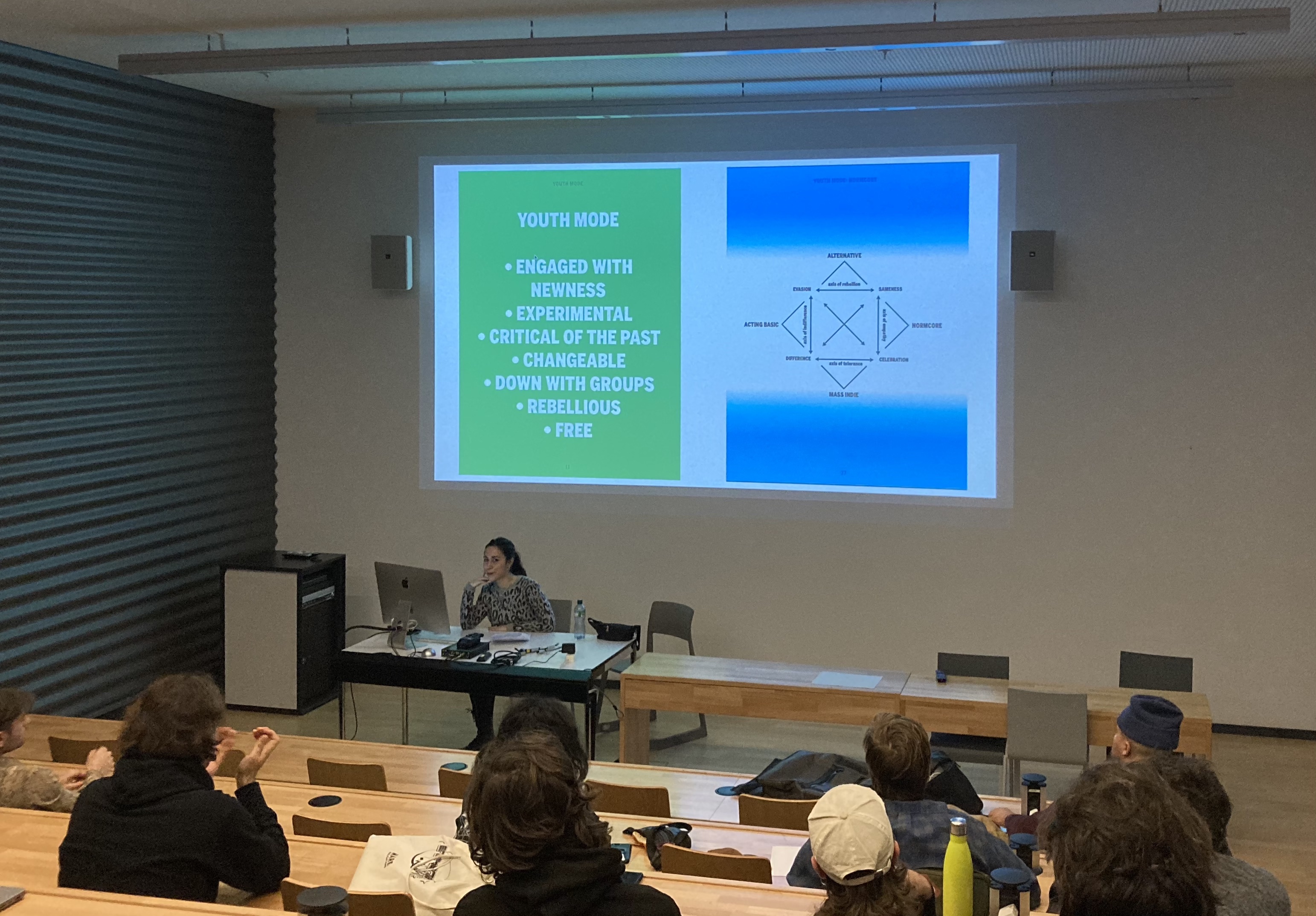
Ingrid Luquet-Gad
Raised On The Internet: Now What?
27 - 28 mars 2023
ECAL/Ecole cantonale d'art de Lausanne
Avec :
Julie Ackermann
Eric Baudelaire
Federico Campagna
Tristan Garcia
Guillaume Heuguet
Gisèle Vienne
Tristan Garcia
L'innocence de l'œil et le bonhomme-têtard. Esthétisation et épistémisation des dessins d'enfant au XIXe et au XXe siècle.
"Enfance" est un concept stratégique. L'un des moments-clef des oppositions autour de ce qu'est l'enfance est l'émergence, au milieu du XIXe siècle, à la fois d'une curiosité esthétique et d'un intérêt épistémique pour les dessins des jeunes enfants. Jusqu'alors négligées, les productions graphiques des plus jeunes deviennent des œuvres en soi, qui peuvent être exposées (à Hambourg, à Londres, à Paris), mais aussi des modèles pour les artistes (la "classe d'art juvénile" de Frank Cizek, au sein de la Sécession viennoise). A partir du moment où John Ruskin évoque une "innocence de l'œil" dans son traité de dessin, le graphisme enfantin devient aussi un possible idéal de l'œuvre d'art moderne autonome, produite par jeu, désintéressée, spontanée, délivrée des conventions sociales adultes.
A cette voie, qu'on appellera "la voie de Ruskin", on opposera "la voie de Spencer": au même moment, dans ses très influents articles de pédagogie, l'évolutionniste Herbert Spencer prend pour exemple des stades de développement de l'intelligence humaine les stades de développement du dessin d'enfant.
Celui-ci servira désormais de test de l'évolution de la motricité, des émotions et de la cognition, jusqu'à l'élaboration du célèbre "test du bonhomme" par Florence Goodenough.
Ce test servira à pré-établir le "degré d'intelligence" de nombreuses générations d'enfants et accompagnera l'élaboration des normes modernes de la jeunesse, de la répartition en classes d'âge, de la définition de la déficience mentale aussi bien que des "enfants surdoués".
On s'attardera ensuite sur la mise en parallèle, à partir des années 1860 de dessins d'enfants, d'œuvres de peuples alors dits "primitifs" et de peintures rupestres du Paléolithique supérieur : l'enfance, par l'étude de ses dessins, a permis de mettre sur le même plan l'enfance de chaque individu, l'enfance de l'humanité toute entière et des peuples infantilisés, considérés comme de "grands enfants", dans le cadre de théories évolutionnistes dites "de la récapitulation".
De ces usages du dessin d'enfant on tirera enfin la thèse selon laquelle la définition de l'enfance (quand elle commence et quand elle finit, sa part naturelle et sa part sociale, son découpage en stades de développement) joue toujours un rôle stratégique dans le découpage des catégories de notre humanité : en découpant les âges de la vie, ce sont aussi les populations, les cultures, les genres et les classes sociales qu'on découpe et qu'on ordonne.
Tristan Garcia
L'innocence de l'œil et le bonhomme-têtard
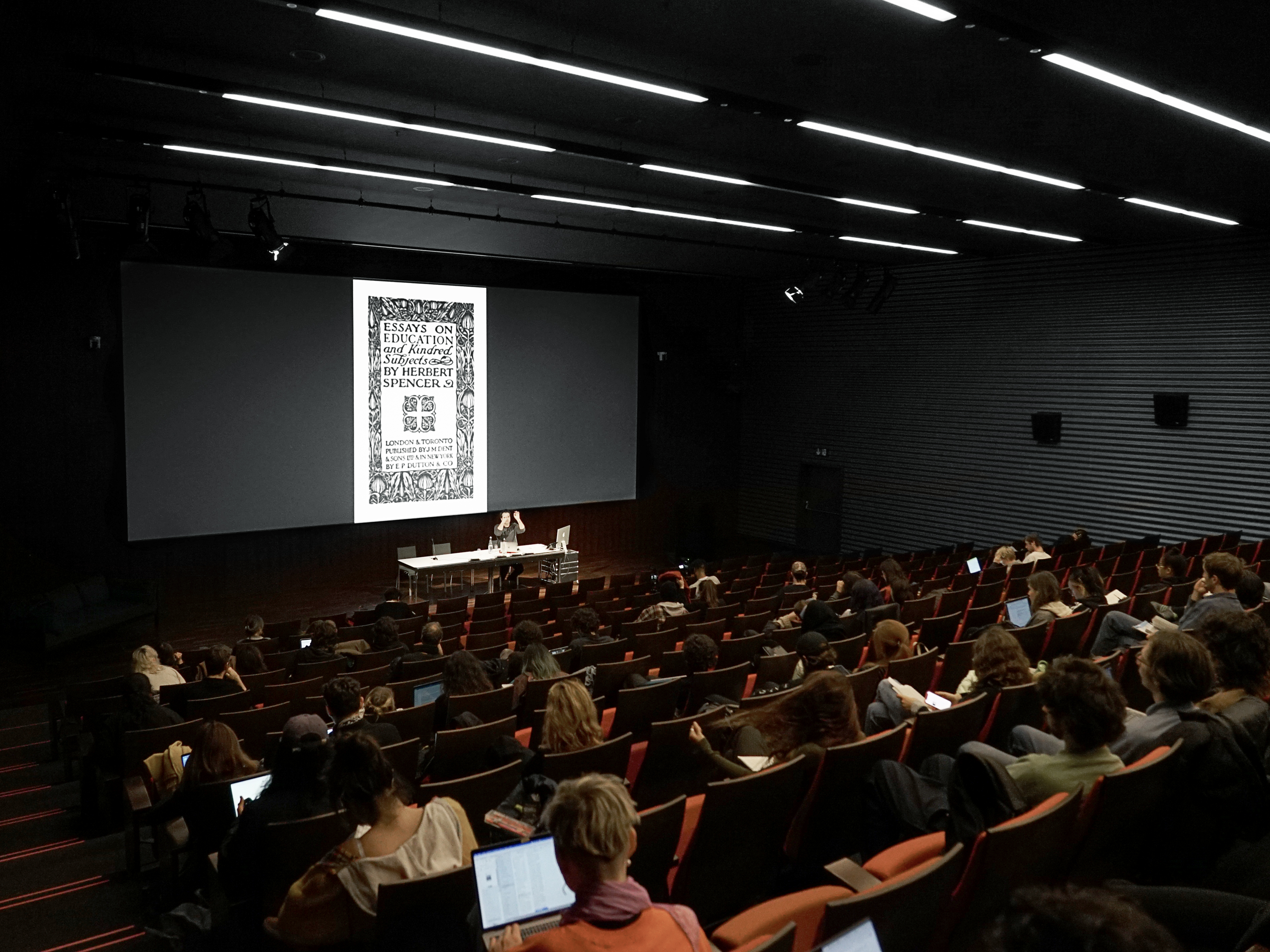
Tristan Garcia
L'innocence de l'œil et le bonhomme-têtard
Crédit : Marvin Merkel
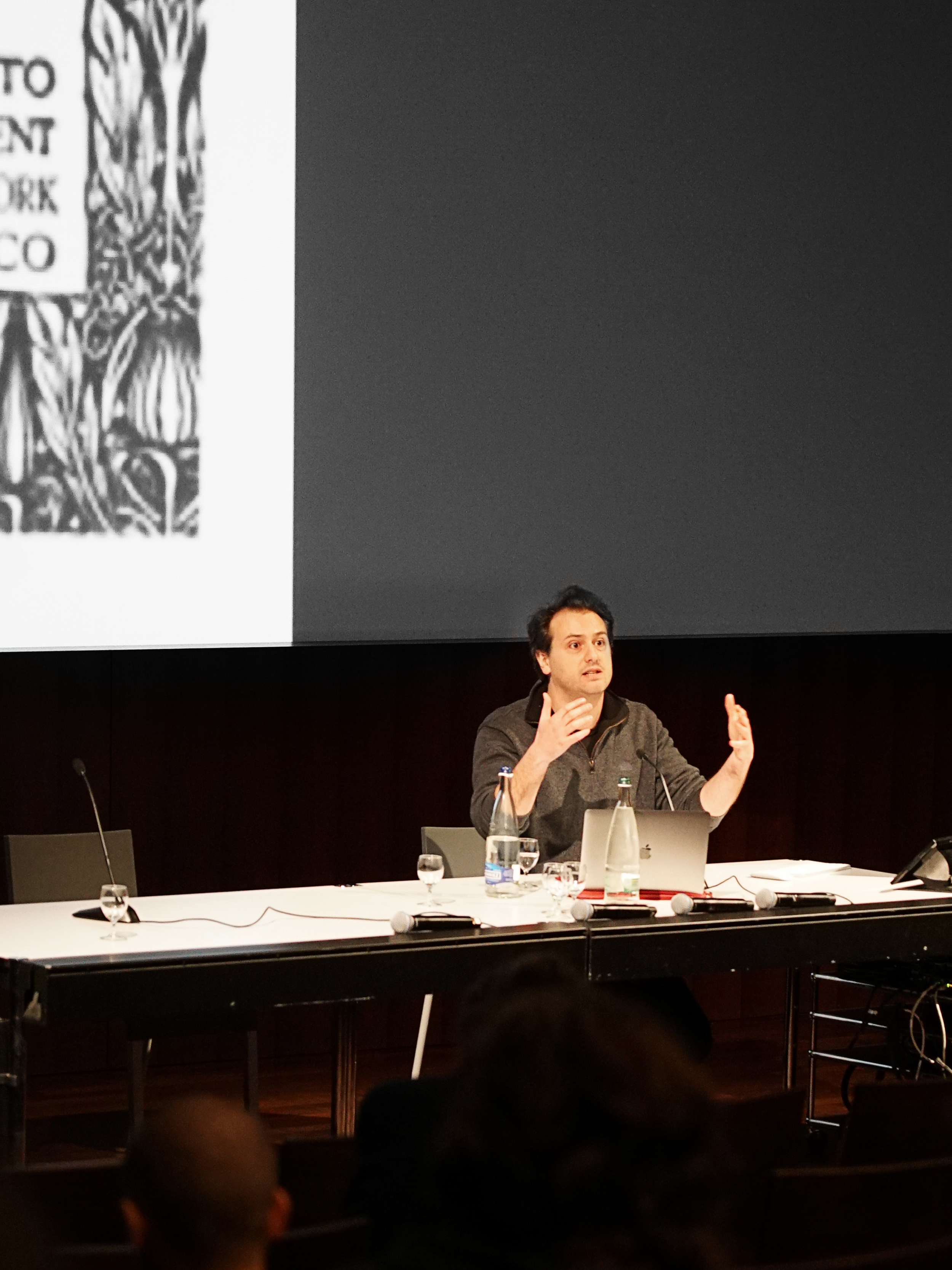
Tristan Garcia
L'innocence de l'œil et le bonhomme-têtard
Crédit : Marvin Merkel
Gisèle Vienne
Extra Life
La pratique artistique de Gisèle Vienne est traversée par l'articulation entre nos cadres perceptifs et les rapports de domination que ceux-ci tendent sans cesse à naturaliser, à faire apparaître comme inévitables, atemporels, sans histoire. Dans les travaux de l’artiste, cette articulation prend la forme de l’apparition récurrente de certaines formes incarnées de la jeunesse : les rituels de l’enfance, la morphologie mécanique de la marionnette, ou encore le corps adolescent sont saisis - souvent par le langage chorégraphique - dans leur rapport de résistance ou de révolte à “l’éducation à la cruauté” que leur impose l’espace social. Cette conversation sera l’occasion de traverser les catégories politiques et esthétiques qui structurent les recherches artistiques de Gisèle Vienne, à partir d’extraits de plusieurs de ses pièces filmiques et chorégraphiques.
Gisèle Vienne
Extra Life
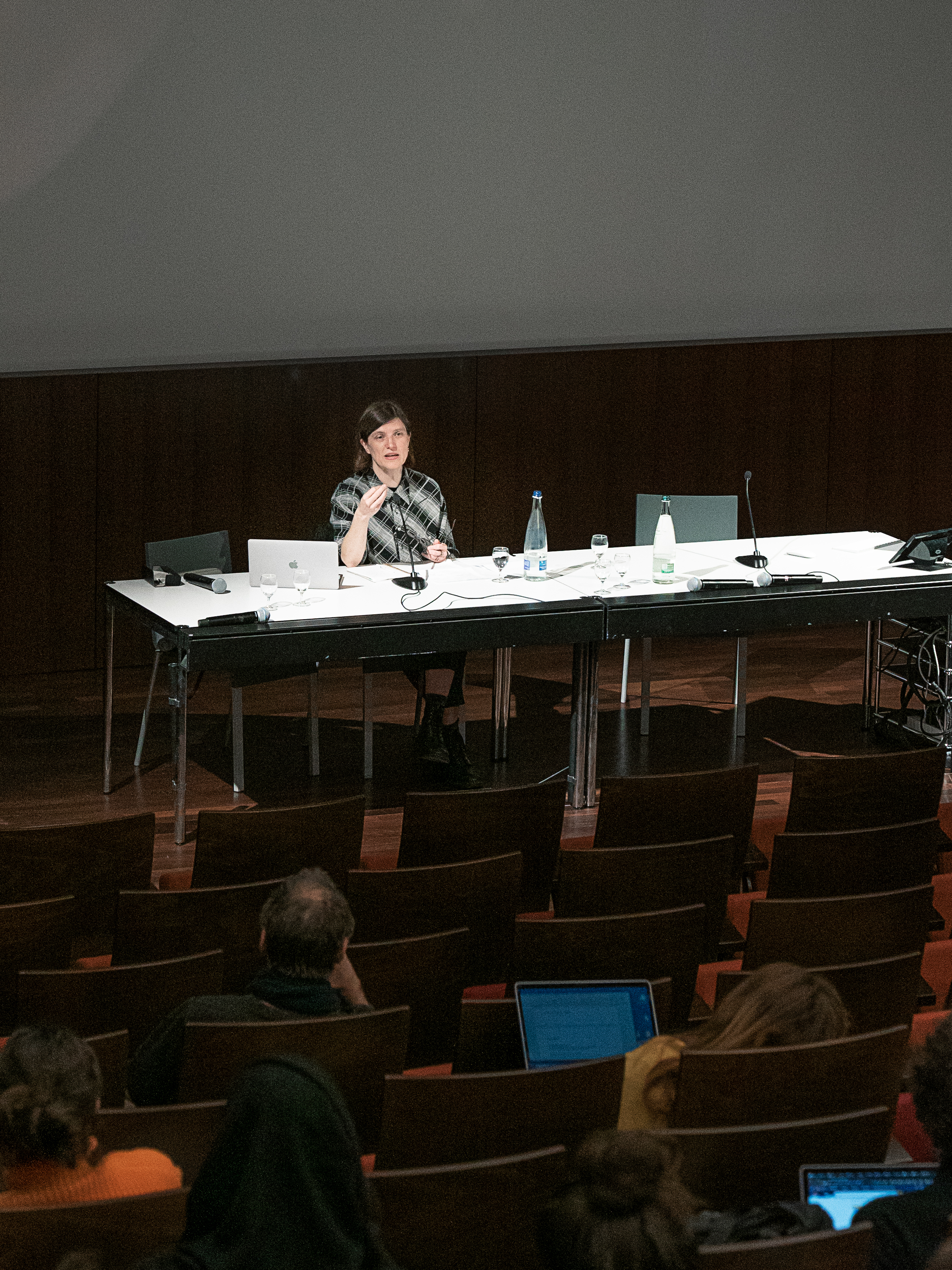
Gisèle Vienne
Extra Life
Crédit : Marvin Merkel
Eric Baudelaire
Anabases
Dans un important corpus d'œuvres filmiques conçues depuis 2010, Eric Baudelaire articule l'écriture documentaire et l'enquête historique, produisant une indiscernabilité entre faits socio-politiques et fictions de mémoires inventées. Dans cette articulation, une figure émerge régulièrement à travers son oeuvre, celle de la représentation des âges : enfants, jeunes, mais aussi octogénaires, qui apparaissent dans les films de l'artiste comme les protagonistes des rapports entre la mémoire politique collective et l'expérience subjective de la destruction ou de la création, entre le temps historique et les régimes d'invention de la tradition, ou encore entre le document visuel et ses régimes de vérité.
A partir de plusieurs films de l'artiste (L'Anabase de May et Fusako Shigenobu, Masao Adachi, et 27 années sans images, 2011 ; Also Known as Jihadi, 2017 ; Un film dramatique, 2019 ; When There Is No More Music to Write, and Other Roman Stories, 2022), cette conversation prendra la forme d'une "anabase" (figure philosophique et littéraire chère à l'artiste, qui renvoie à une structure narrative composée d'un embarquement, d'une errance et d'un retour) à travers les âges et leurs représentations, et explorera les liens des travaux d'Eric Baudelaire à la représentation de l'âge comme allégorie de l'histoire, mais aussi et plus largement comme vecteur d'accès privilégié aux catégories et idées qui animent sa production artistique.
Eric Baudelaire
Anabases
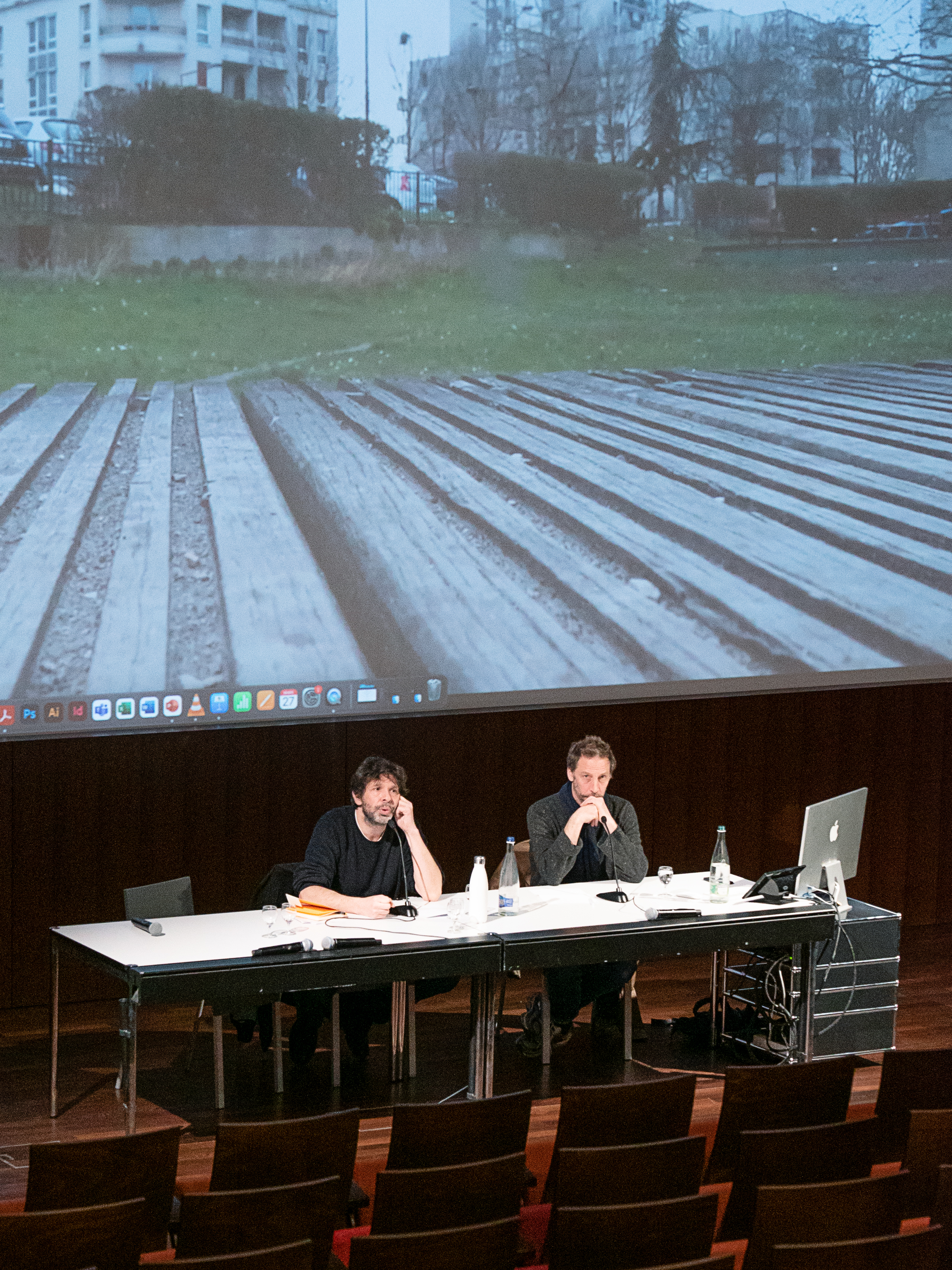
Eric Baudelaire
Anabases
Crédit : Marvin Merkel
Federico Campagna
Younger than you: talking with post-future adolescents
We are born as infants, then we grow young, adult, old and finally we die. Nobody seems to be able to escape the linearity of time. And yet, as metaphysicians and scientists do not tire to repeat, time is not something that really exists, let alone exist linearly. It is possible, for example, to be young and old at the same time – as it happens to those who have been alive only for a few years, but within a world that is nearing its end. In this talk, philosopher Federico Campagna will try to shed some light on those who will be young in a young world: the post-future adolescents who will create a new reality after the end of the one we inhabit today.
Federico Campagna
Younger than you
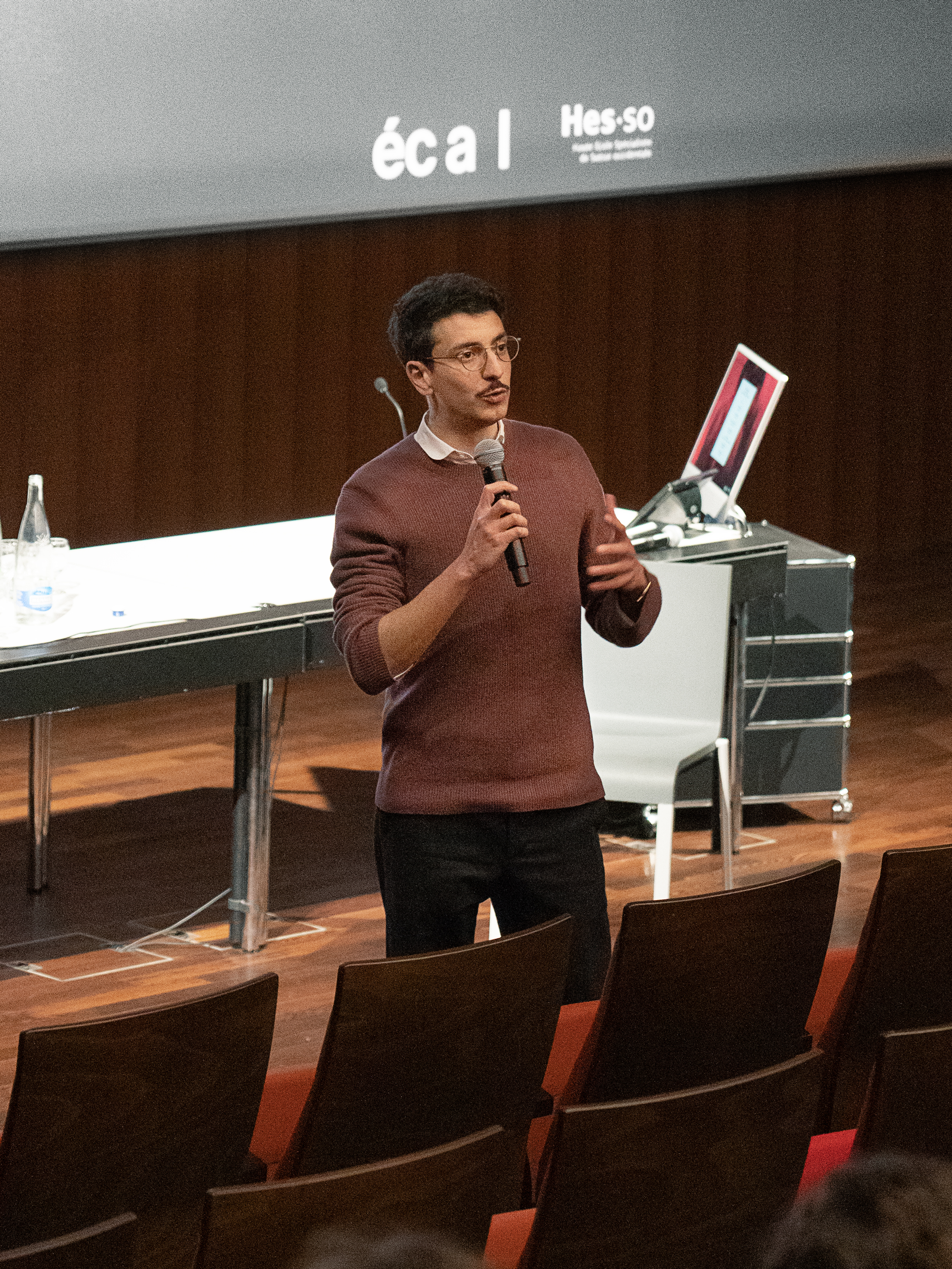
Federico Campagna
Younger than you
Crédit : Marvin Merkel
Guillaume Heuguet
“Youth Music”, ageism and the politics of time
The relationship between youth and popular music is an issue for critics and theorists. Lawrence Grossberg argues, for example, that while popular music (from pop to rave) is seen as music through which youth express themselves and which express a certain idea of youth, the youth in question is in fact mostly constructed as such by a specific generation, the baby boomers. The musical discussions that oppose "Gen Z" and "the boomers" seem to react to this ethnocentrism of age.
Indeed, if there is a social relationship of power that we would call ageism, then it seems that it concerns the young as much as the old, thus almost everyone: it can then seem difficult to identify a material basis to gather those who would then be on the wrong side of this relationship, for example excluded from positions of economic power. Moreover, the distinction of the ages seems to operate as much by the exclusion as by the valorization, even the fetishism of certain ages. I will thus try to show how current popular music, from rap to techno, reflects these problems, not only by addressing them explicitly, but also by intervening in a sensitive and critical way on our experiences of time, which we depend upon for intergenerational political alliances.
Guillaume Heuguet
“Youth Music”
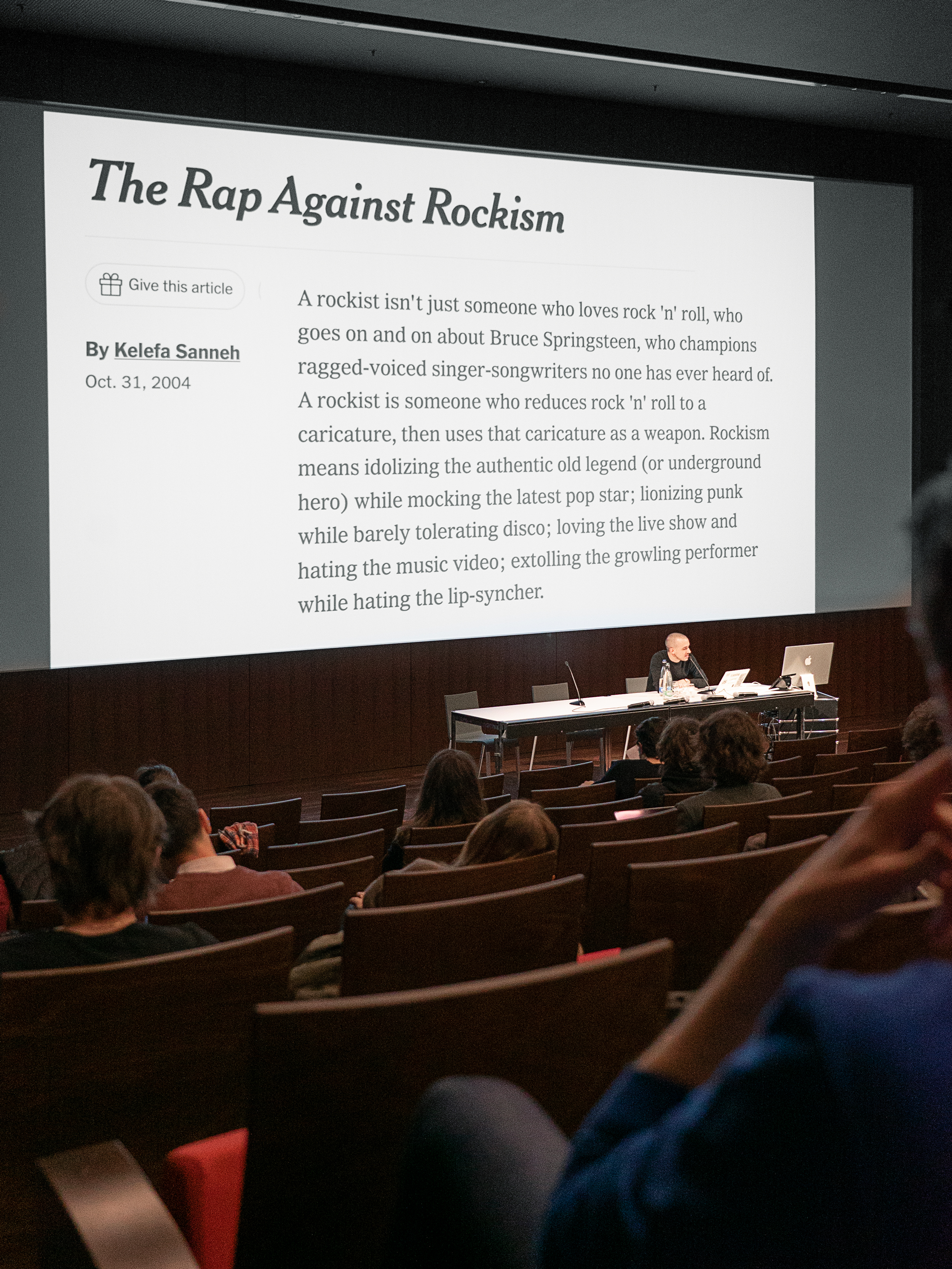
Guillaume Heuguet
Youth Music
Crédit : Marvin Merkel
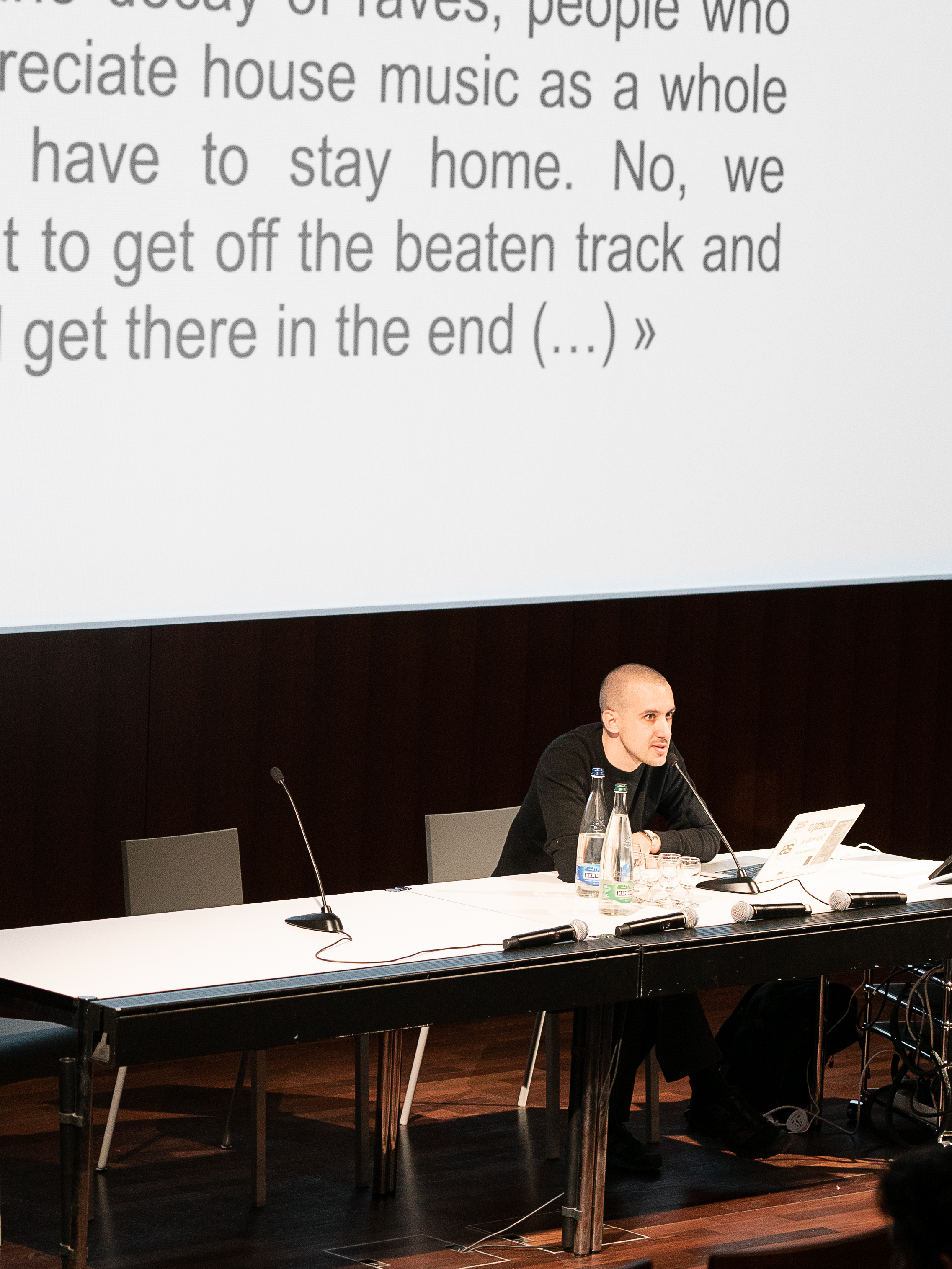
Guillaume Heuguet
Youth Music
Crédit : Marvin Merkel
Julie Ackermann
Pop Hardcore: why did pop become so extreme?
Understood as a manifestation of love for artifice, hyperpop is the name of an aesthetic rebellion that emerged in the early 2010s and appropriating commercial pop music in order to deconstruct it by exaggerating or distorting its characteristic motifs. This conference will examine hyperpop as a cultural style that relies on but also transcends music and can be applied to other cultural productions. It will explain its post-internet context of emergence (attention economy, acceleration and platform capitalism) and understand it as an digital actualisation of the "camp" style theorized by Sunsan Sontag. It will try to understand the specificity of this extreme style focused on fun, and the new aesthetic category it relies on : the cringe, an awkwardness the hyperloop style celebrates to enhance a new kind of sincerity in a context of digital and cultural irony and nihilism.
Julie Ackermann
Pop Hardcore: why did pop become so extreme?
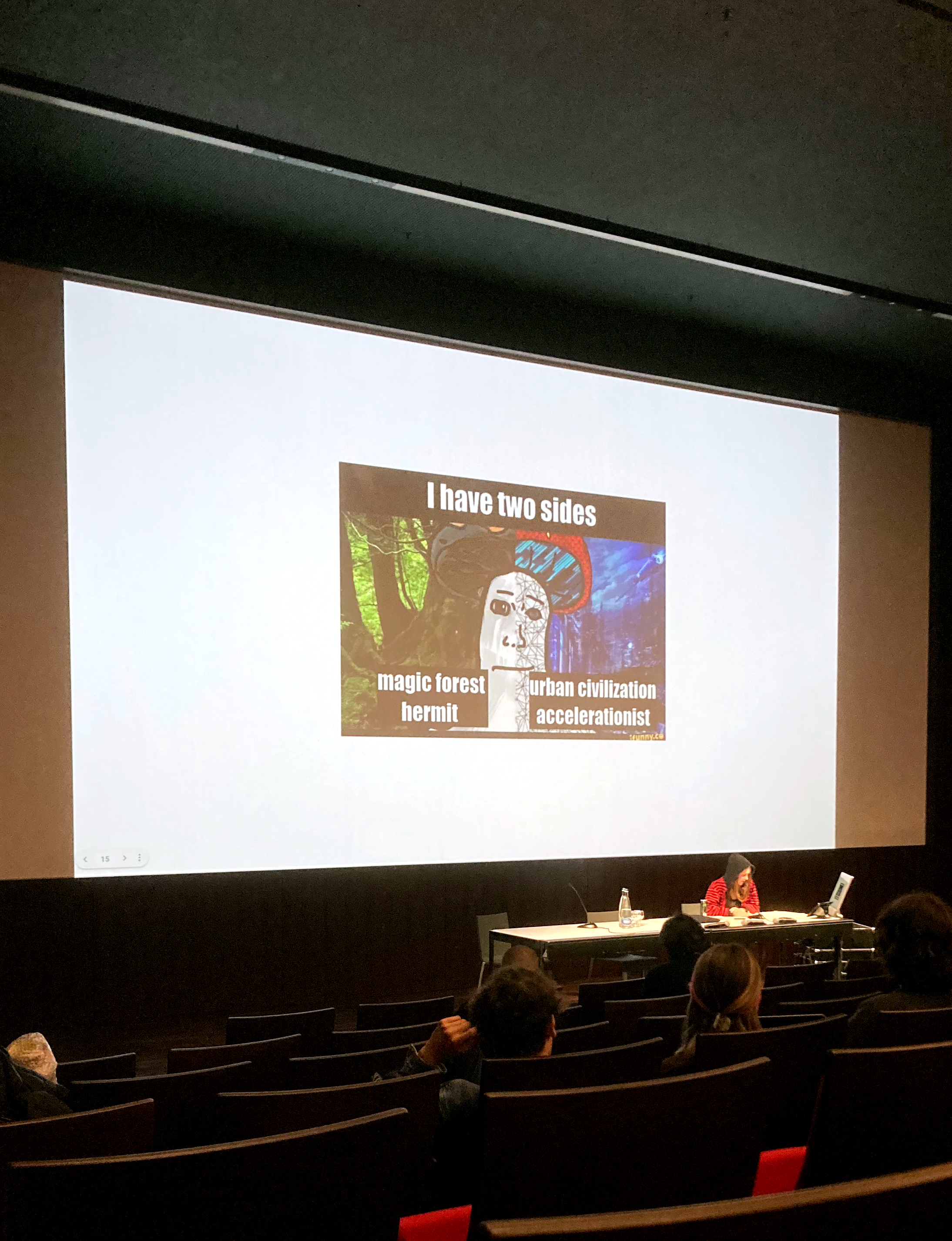
Julie Ackermann
Pop Hardcore
Lorenzo Benzoni & Luca Frati
Immaterial forever: representations of queer adolescence through the hyperpop community
To grow up queer means forgetting the linearity of time. It means mistrusting chronology and to multiply timelines. Understanding identity as a never ending flux of transformations, and adolescence not as a biological age but as something that can happen multiple times, over and over again. Queerness is the key to decomposing social norms and expectations (regarding gender, but not only). If there are no more fixed states, as a consequence there could be infinite states, if there is nothing concrete to hold on to, there is complete freedom: IMMATERIAL FOREVER. This title quotes in fact the work of late musician Sophie who, through their thought and production, triggered new reflections on gender and opened up new spaces for queer youth to thrive. Beginning with Sophie, this talk questions the connection between queerness and hyperpop, framing the latter as an elected space for the former to express and determine itself.
Hyperpop is increasingly becoming a container for queer kids to find their safe space and a caring community. The genre itself is fed by queer artists and their experimentations, which often depict youth and take it as their focal point. Taking mainstream culture as an example, it is possible to understand the relationship between the representation of the queer subject and the feeling of post-ironic despair inherent of hyperpop, a genre that reached the mainstream during a time of total disorientation and disillusionment (the pandemic era and its aftermaths).
This reflection on the theme is proposed by ECAL alumni Lorenzo Benzoni and Luca Frati as artists who are navigating contemporary culture and are deeply interested in every shade of pop. It has to be intended also as a selection of references that are dear to them and are feeding both their practices.
Lorenzo Benzoni & Luca Frati
Immaterial forever
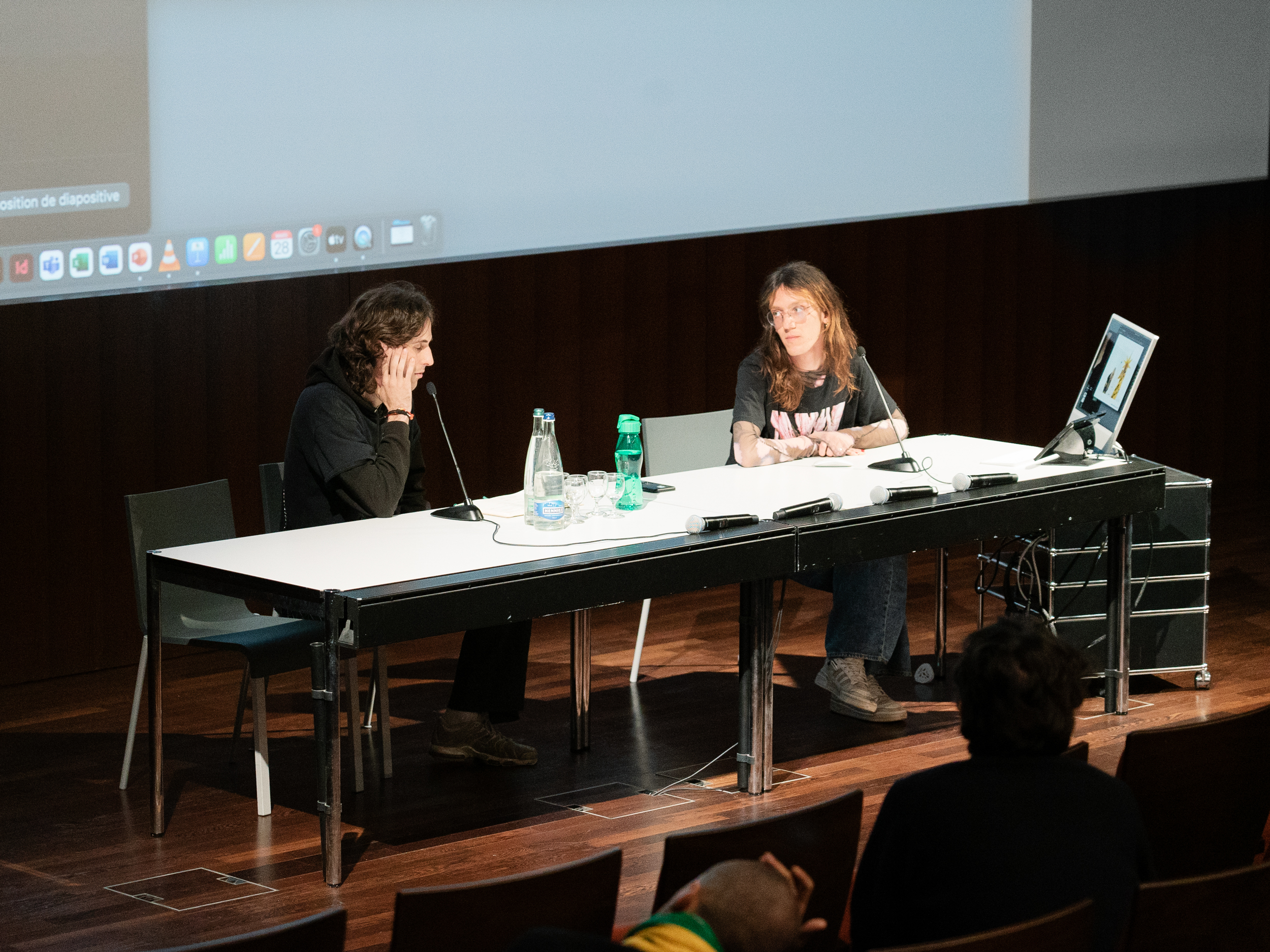
Lorenzo Benzoni & Luca Frati
Immaterial forever
Crédit : Marvin Merkel